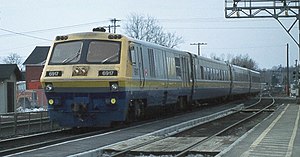Bombardier LRC
| Bombardier LRC-2 and LRC-3 | |
|---|---|
|
LRC # 6917 in Brockville, Ontario
|
|
| Numbering: | M6109-01 - M6109-21 M6125-01 - M6125-10 VIA 6900–6930 |
| Number: | LRC-2:21, LRC-3: 10 |
| Manufacturer: |
Bombardier Transportation Fuji Electric |
| Year of construction (s): | 1980-1984 |
| Retirement: | 2001 (locomotives) |
| Axis formula : | Bo′Bo ′ |
| Gauge : | 1435 mm ( standard gauge ) |
| Length: | 19.86 m (65 ft 2 in) |
| Height: | 3.94 m (12 ft 11 in) |
| Width: | 3.2 m (10 ft 5 1⁄2 in) |
| Service mass: | 113.4 t - 116.1 t |
| Top speed: | 153 km / h (95 mph) on duty |
| Installed capacity: | 2740 kW (3725 hp) |
| Motor type: | 16-cylinder |
| Power transmission: | electric |
| Drive: | diesel-electric |
| Train heating: | HEP 480 volts |
The LRC of Bombardier Transportation was a diesel electric intercity bandwagon for passenger transport in Ontario and Quebec ( Canada ). The name is a double abbreviation for English Light, Rapid, Comfortable and French Léger, Rapide, et Confortable (light, fast, comfortable). The internal designation was M-429 for the prototype and M-437 for the series version.
The train concept consists of suitable locomotives and intermediate cars, which can, however, also be operated separately. With two locomotives at the Zugspitze and at the end of the train, a train composition can reach a top speed of 201 km / h (125 mph), while test drives also measured 210 km / h (130 mph). In order to be able to be used on the North American old building routes, the LRC are equipped with active tilting technology. In normal operation, however, they did not drive more than 153 km / h (95 mph). VIA Rail Canada ordered the first 10 locomotives with 50 intermediate cars in 1978 and then added another 10 trains to the order. After their delivery from June 1, 1981, another generation of 10 locomotives and 50 intermediate cars was ordered. Most of the locomotives were taken out of service at the end of their regular 15-year service, the last one (# 6905) continued to run until 2001.
Both the tilting technology and the LRC name were originally developed by Montreal Locomotive Works since 1971, which were bought by Bombardier in 1975. Due to a reorganization at the original client VIA Rail Canada, the production of the LRC was postponed. The two first generation trains (LRC-1) then went to Amtrak (No. 38 and 39), which they have tested since 1980 and returned in 1982. The technical differences to the successor generations were so great that hardly any parts could be taken over from the five delivered locomotives and the LRC-1 were then scrapped in 1990.
The LRC's tilting technology has influenced subsequent vehicles, including the Acela Express in the Northeast Corridor , the Super Voyager in the UK and the JetTrain in North America.
In contrast to the LRC locomotives, the intermediate wagons were still used by VIA Rail and were completely overhauled from 2000. At the beginning of 2012, 98 intermediate cars were still in operation.
literature
- Louis A. Marre and Paul K. Withers: The Contemporary Diesel Spotter's Guide . Year 2008 edition. Withers Publishing, Halifax, PA 2008, ISBN 1-881411-53-2 .
Web links
- Save The LRC (Toronto Railway Historical Association)
Individual evidence
- ↑ VIA Rail (English) accessed on February 28, 2012
- ↑ VIA Rail (English) accessed on February 28, 2012
